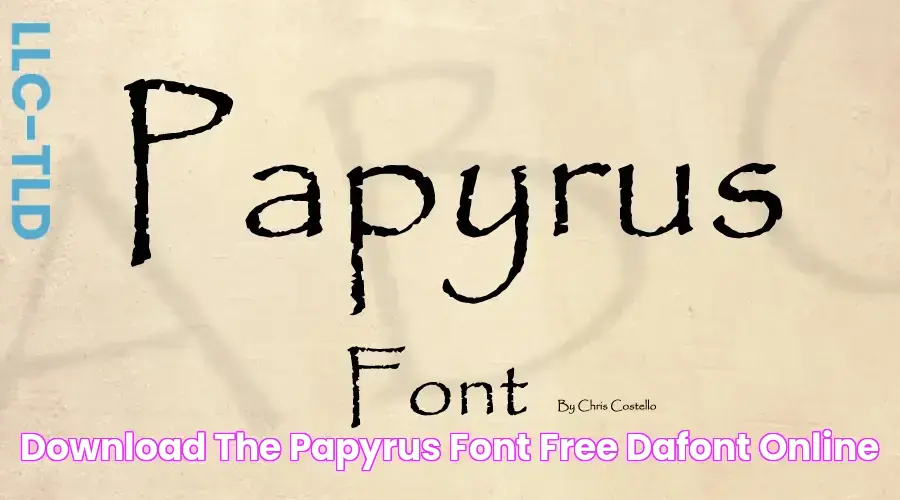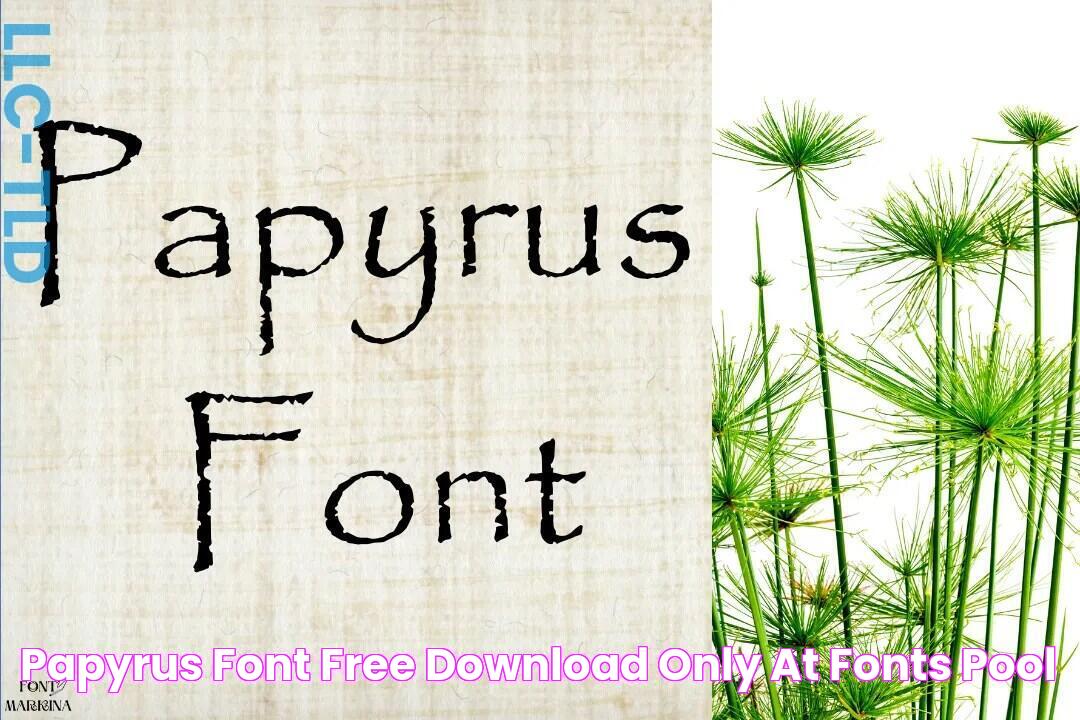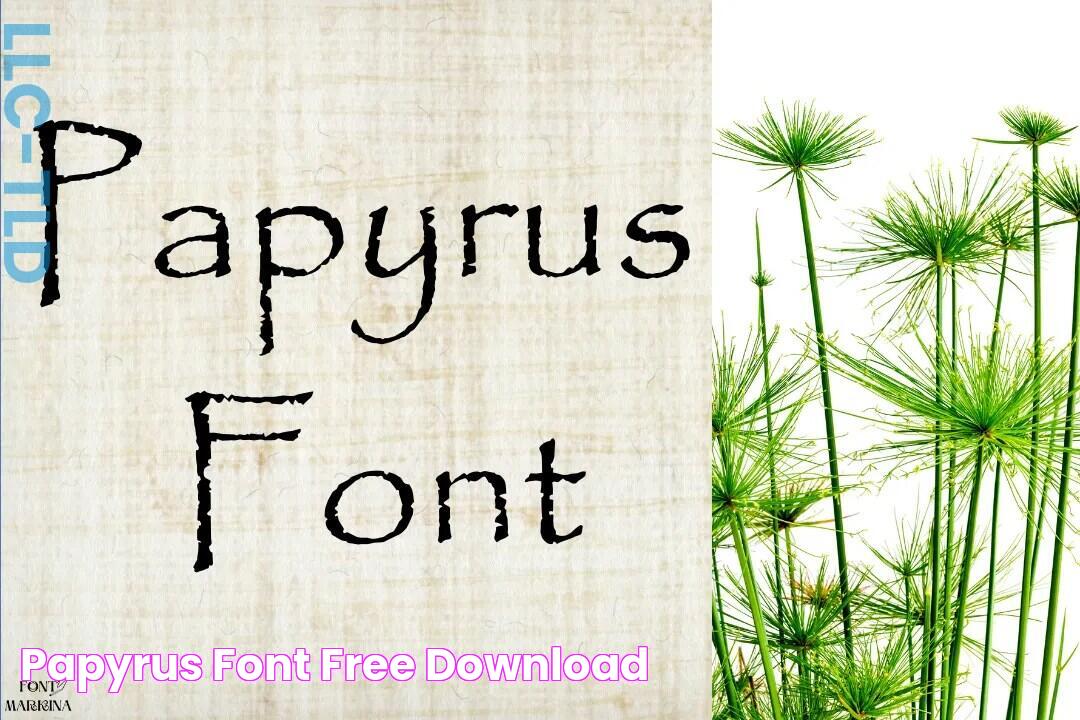Papyrus Font: The Ultimate Guide To Ancient Aesthetics
Papyrus font is a typeface that emulates the writing style used on papyrus scrolls in ancient Egypt. It is characterized by its thick, vertical strokes and rounded corners, giving it a distinctive and recognizable appearance. An example of a papyrus font is the "Papyrus" font, which is commonly used in word processing and design software.
Papyrus font is often used to create a sense of antiquity or historical authenticity in documents, designs, and other creative works. Its unique appearance makes it a popular choice for projects related to ancient Egypt, history, or archaeology. Additionally, papyrus font can add a touch of elegance and sophistication to invitations, greeting cards, and other formal communications.
In this article, we will explore the history, characteristics, and uses of papyrus font in more detail. We will also discuss the benefits and drawbacks of using papyrus font and provide tips on how to use it effectively in your own projects.
Read also:Uncover The Truth Kazembe Ajamu Colemans Measured Height
Papyrus Font
Papyrus font, a typeface inspired by ancient Egyptian writing, has several key aspects that contribute to its unique identity and:
- Thick strokes
- Rounded corners
- Vertical emphasis
- Historical authenticity
- Formal appearance
- Widely recognized
The thick strokes and rounded corners of papyrus font give it a distinctive and easily recognizable appearance. Its vertical emphasis mimics the writing style of ancient Egyptian scribes, adding a sense of historical authenticity to documents and designs. Papyrus font's formal appearance makes it suitable for invitations, greeting cards, and other formal communications. Its wide recognition ensures that it is easily understood and conveys the intended message effectively.
1. Thick strokes
In the context of papyrus font, thick strokes play a significant role in defining its unique visual characteristics and conveying a sense of historical authenticity.
- Historical accuracy
Thick strokes are a defining feature of ancient Egyptian hieroglyphics and hieratic scripts, which served as the inspiration for papyrus font. By incorporating thick strokes, papyrus font emulates the writing style of ancient scribes, adding a touch of historical authenticity to documents and designs. - Visual impact
The thick strokes of papyrus font create a bold and visually striking appearance. This makes it an effective choice for capturing attention and creating emphasis in headings, titles, and other important text elements. - Legibility
Despite their thickness, the strokes in papyrus font are carefully designed to maintain legibility. The rounded corners and vertical emphasis ensure that characters are easily distinguishable, even at small sizes. - Distinctive style
The thick strokes of papyrus font set it apart from other typefaces, giving it a distinctive and recognizable style. This makes it a popular choice for projects where a unique and memorable visual aesthetic is desired.
Overall, the thick strokes of papyrus font serve multiple purposes, contributing to its historical authenticity, visual impact, legibility, and distinctive style, making it a versatile and effective typeface for a variety of design applications.
2. Rounded corners
Rounded corners, a distinctive feature of papyrus font, contribute to its unique visual appeal and historical authenticity.
- Historical accuracy
Rounded corners are a characteristic element of ancient Egyptian hieroglyphics and hieratic scripts. By incorporating rounded corners, papyrus font emulates the writing style of ancient scribes, adding a touch of historical accuracy to documents and designs. - Visual softness
Rounded corners create a softer and more inviting visual appearance compared to sharp corners. This makes papyrus font suitable for designs and documents that aim to convey a sense of warmth, friendliness, or elegance. - Improved readability
Rounded corners can enhance the readability of papyrus font, especially at smaller sizes. The smooth curves reduce the likelihood of jagged edges or pixelation, making characters easier to distinguish and recognize. - Distinctive style
Rounded corners are a defining feature that sets papyrus font apart from other typefaces. This unique style makes it a popular choice for projects where a distinctive and memorable visual aesthetic is desired.
Overall, the rounded corners of papyrus font serve multiple purposes, contributing to its historical authenticity, visual appeal, readability, and distinctive style, making it a versatile and effective typeface for a variety of design applications.
Read also:Your Trusted Funeral Home In Gainesville Tx Compassionate Care
3. Vertical emphasis
Vertical emphasis, a prominent characteristic of papyrus font, contributes significantly to its distinctive appearance and historical authenticity.
In ancient Egyptian hieroglyphics and hieratic scripts, verticality played a crucial role. Scribes wrote on papyrus scrolls, which were held vertically, resulting in a writing style that emphasized vertical lines and characters. Papyrus font emulates this writing style by incorporating vertical emphasis, adding a touch of historical accuracy to documents and designs.
The vertical emphasis in papyrus font is achieved through several design elements:
- Tall, narrow characters: The characters in papyrus font are typically tall and narrow, with a strong vertical orientation.
- Vertical strokes: The strokes that make up the characters are predominantly vertical, creating a sense of height and elongation.
- Limited horizontal strokes: Horizontal strokes are used sparingly in papyrus font, further emphasizing the vertical orientation.
The vertical emphasis in papyrus font serves multiple purposes:
- Historical authenticity: The vertical emphasis mimics the writing style of ancient Egyptian scribes, adding a touch of historical accuracy to documents and designs.
- Distinctive style: The vertical emphasis sets papyrus font apart from other typefaces, giving it a unique and recognizable style.
- Visual impact: The vertical emphasis creates a visually striking appearance, drawing attention to text elements and enhancing their impact.
- Improved readability: The vertical emphasis can improve readability, especially at smaller sizes, by reducing the likelihood of characters appearing cluttered or crowded.
Overall, the vertical emphasis in papyrus font is an essential component that contributes to its historical authenticity, distinctive style, visual impact, and readability, making it a versatile and effective typeface for a variety of design applications.
4. Historical authenticity
Papyrus font's connection to historical authenticity stems from its emulation of the writing style and materials used in ancient Egypt. This connection manifests in several ways:
- Writing style
Papyrus font mimics the vertical emphasis, thick strokes, and rounded corners of ancient Egyptian hieroglyphics and hieratic scripts. This emulation lends a sense of historical authenticity to documents and designs that incorporate papyrus font. - Papyrus material
The name "papyrus" itself refers to the material used to create scrolls in ancient Egypt. Papyrus font's evocation of this material further enhances its historical authenticity, as it associates the font with the ancient writing practices of a significant civilization. - Historical usage
Papyrus font has been used in various contexts to create a sense of historical authenticity. For example, it has been employed in films, documentaries, and museum exhibits related to ancient Egypt to recreate the look and feel of ancient texts and inscriptions. - Cultural significance
Papyrus font has become synonymous with ancient Egyptian culture and history. Its use in various media and contexts has contributed to its recognition as a symbol of historical authenticity and cultural heritage.
In conclusion, papyrus font's connection to historical authenticity lies in its emulation of ancient Egyptian writing styles, its association with papyrus as a writing material, its use in historical contexts, and its cultural significance as a symbol of ancient Egypt.
5. Formal appearance
Papyrus font's formal appearance is a defining characteristic that contributes to its widespread use in various formal and semi-formal contexts. This formality stems from several key factors:
- Historical roots
Papyrus font's connection to ancient Egyptian writing, particularly hieroglyphics, lends it an air of formality. Hieroglyphics were used in religious texts, official documents, and other formal contexts, imbuing papyrus font with a sense of historical significance and formality. - Vertical emphasis
The pronounced vertical emphasis in papyrus font creates a sense of structure and order. Vertical lines are often associated with formality and authority, making papyrus font suitable for documents that require a formal tone. - Thick strokes
The thick strokes of papyrus font add weight and substance to the typeface, contributing to its formal appearance. Thick strokes are often perceived as being more serious and authoritative, making papyrus font a good choice for documents that need to convey a sense of importance. - Limited ornamentation
Papyrus font is relatively, with limited ornamentation or decorative elements. This simplicity contributes to its formal appearance, as excessive ornamentation can sometimes detract from the seriousness of a document.
In conclusion, papyrus font's formal appearance is a result of its historical roots, vertical emphasis, thick strokes, and limited ornamentation. These factors combine to make papyrus font a suitable choice for formal and semi-formal contexts, where a sense of seriousness, authority, and historical authenticity is desired.
6. Widely recognized
Papyrus font's wide recognition is a significant factor contributing to its widespread use and appeal. This recognition stems from various factors and has several implications in the context of the font's usage:
- Historical significance
Papyrus font's connection to ancient Egyptian writing and its historical significance contribute to its wide recognition. The font's unique appearance and association with a rich cultural heritage make it easily identifiable and recognizable. - Cultural impact
Papyrus font has been featured in numerous cultural contexts, including films, television shows, and literature, further enhancing its recognition. Its association with ancient Egypt and historical themes has made it a familiar sight for audiences worldwide. - Visual distinctiveness
Papyrus font's distinctive visual characteristics, such as its thick strokes, rounded corners, and vertical emphasis, make it highly recognizable. This visual distinctiveness ensures that the font stands out and is easily recalled by viewers. - Cross-cultural appeal
Papyrus font's wide recognition extends across different cultures and regions. Its association with ancient Egypt and its use in various cultural contexts have made it a globally recognized font, transcending cultural boundaries.
In conclusion, papyrus font's wide recognition is a result of its historical significance, cultural impact, visual distinctiveness, and cross-cultural appeal. This recognition makes the font a popular and versatile choice for designers and users who seek to convey a sense of history, authenticity, or cultural connection in their projects.
Frequently Asked Questions about Papyrus Font
This section addresses some of the most common questions and misconceptions surrounding papyrus font. Each question is answered thoroughly and informatively, providing valuable insights into the font's characteristics, usage, and significance.
Question 1: What is papyrus font?
Papyrus font is a typeface inspired by the ancient Egyptian writing system. It features thick strokes, rounded corners, and a vertical emphasis, emulating the appearance of hieroglyphs and hieratic scripts written on papyrus scrolls.
Question 2: How is papyrus font different from other fonts?
Papyrus font's unique characteristics set it apart from other typefaces. Its thick strokes and rounded corners give it a distinctive visual appearance, while its vertical emphasis mimics the writing style of ancient Egyptian scribes.
Question 3: What are the benefits of using papyrus font?
Papyrus font offers several benefits, including historical authenticity, visual impact, improved readability, and a distinctive style. Its historical roots make it suitable for projects related to ancient Egypt, while its visual appeal enhances the impact of headings, titles, and other important text elements.
Question 4: When is it appropriate to use papyrus font?
Papyrus font is commonly used in projects seeking a sense of historical authenticity or cultural connection to ancient Egypt. It is also suitable for designs aiming to convey a sense of warmth, friendliness, or elegance.
Question 5: Are there any drawbacks to using papyrus font?
While papyrus font offers many benefits, it also has potential drawbacks. Its thick strokes and rounded corners can make it less suitable for small text sizes or contexts requiring high levels of readability.
Question 6: What is the history behind papyrus font?
Papyrus font's roots can be traced back to the ancient Egyptian writing system. Its design was inspired by the hieroglyphics and hieratic scripts used on papyrus scrolls, providing a modern representation of this ancient writing style.
In conclusion, papyrus font is a unique and versatile typeface that offers a range of benefits and historical significance. Its distinctive characteristics and wide recognition make it a popular choice for projects seeking to convey a sense of authenticity, cultural connection, or visual impact.
Tips for Using Papyrus Font
Papyrus font, with its distinctive appearance and historical significance, offers a range of possibilities for creative projects. To maximize its effectiveness, consider the following tips:
Tip 1: Embrace Historical Authenticity
When using papyrus font, consider the historical context and cultural significance it evokes. Utilize it in projects related to ancient Egypt, archaeology, or history to enhance authenticity and create a sense of connection to the past.
Tip 2: Enhance Visual Impact
Papyrus font's thick strokes and rounded corners create a visually striking appearance. Use it to draw attention to important text elements, such as headings, titles, or call-to-actions, and make them stand out from the surrounding text.
Tip 3: Improve Readability
Despite its thick strokes, papyrus font is designed to maintain readability. Use it in appropriate contexts, such as short passages or headings, where its unique characteristics enhance comprehension without compromising clarity.
Tip 4: Consider Context and Tone
Papyrus font conveys a sense of warmth and friendliness. Use it in designs targeting audiences seeking a welcoming and approachable tone. Avoid using it in formal or serious contexts, where a more traditional or professional font may be more suitable.
Tip 5: Experiment with Size and Color
Papyrus font's thick strokes can appear overpowering at larger sizes. Experiment with different sizes to find the optimal balance between visual impact and readability. Additionally, consider using colors that complement the font's historical roots, such as earthy tones or shades of gold.
Tip 6: Avoid Overuse
While papyrus font offers a distinctive style, avoid overusing it. Excessive use can diminish its impact and make the design appear cluttered. Use it sparingly to create targeted visual emphasis.
Tip 7: Respect Historical Context
When using papyrus font in projects related to ancient Egypt or historical themes, ensure accuracy and respect for the cultural context. Avoid combining it with elements that conflict with the historical period or setting.
Tip 8: Explore Creative Applications
Beyond its traditional uses, explore creative applications for papyrus font. Experiment with it in logo design, branding, or artistic projects to create unique and memorable visual identities.
In conclusion, papyrus font offers a range of possibilities for adding historical authenticity, visual impact, and cultural connection to your projects. By following these tips, you can harness its unique characteristics effectively and create designs that resonate with your intended audience.
Conclusion
Papyrus font, with its distinctive thick strokes, rounded corners, and vertical emphasis, evokes the rich history and cultural significance of ancient Egypt. Its unique characteristics make it a valuable tool for designers seeking to convey a sense of authenticity, warmth, and visual impact.
From historical documents to creative projects, papyrus font offers a versatile and recognizable style. By understanding its historical context, embracing its visual appeal, and considering its appropriate usage, designers can harness the power of papyrus font to create designs that resonate with audiences and leave a lasting impression.
Discover The World Of Nikki Lavay: Inspiring Lives And Empowering Stories
The Definitive Guide To The Sagittarius Male: Unraveling Their Personality Traits And Quirks
Discover The Timeless World Of Rerun: Exploring Charles M. Schulz's Peanuts Universe


